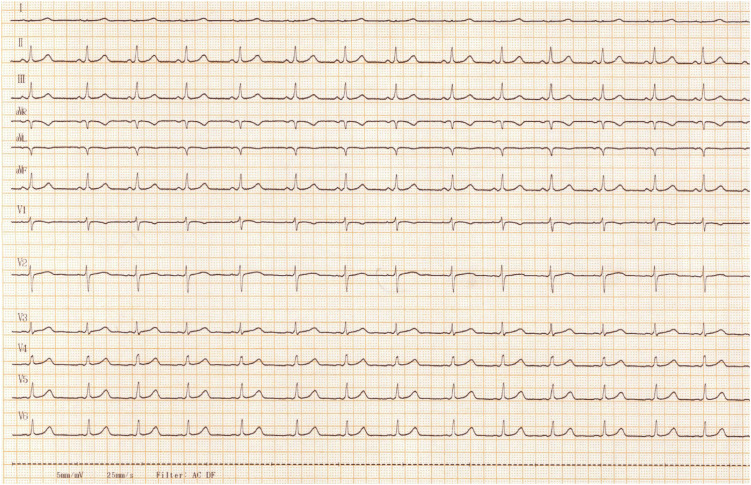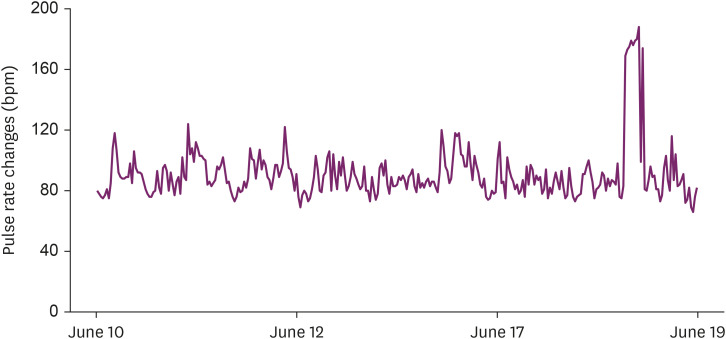Articles
- Page Path
- HOME > Ann Occup Environ Med > Volume 33; 2021 > Article
- Case Report Digital health care and arrhythmia: a case of WPW syndrome in South Korea, 2020
-
Eunchan Mun1
 , Jihee Hong1
, Jihee Hong1 , Sunggu Kwon2
, Sunggu Kwon2 , Sung Ho Lee3
, Sung Ho Lee3 , Wonsool Kim1
, Wonsool Kim1 , Changhwan Lee1
, Changhwan Lee1
-
Annals of Occupational and Environmental Medicine 2021;33:e8.
DOI: https://doi.org/10.35371/aoem.2021.33.e8
Published online: March 24, 2021
1Department of Occupational and Environmental Medicine, Kangbuk Samsung Hospital, Sungkyunkwan University School of Medicine, Seoul, Korea.
2Department of Innovation Healthcare Planning, Kangbuk Samsung Hospital, Sungkyunkwan University School of Medicine, Seoul, Korea.
3Division of Cardiology, Department of Internal Medicine, Kangbuk Samsung Hospital, Sungkyunkwan University School of Medicine, Seoul, Korea.
- Correspondence: Changhwan Lee, MD. Department of Occupational and Environmental Medicine, Kangbuk Samsung Hospital, Sungkyunkwan University School of Medicine, 29 Saemunan-ro, Jongno-gu, Seoul 03181, Korea. scottblacklee@gmail.com
Copyright © 2021 Korean Society of Occupational & Environmental Medicine
This is an Open Access article distributed under the terms of the Creative Commons Attribution Non-Commercial License (https://creativecommons.org/licenses/by-nc/4.0/) which permits unrestricted non-commercial use, distribution, and reproduction in any medium, provided the original work is properly cited.
Abstract
-
Background The digital health care field is expanding from the daily monitoring of chronic diseases to the detection of acute diseases, such as arrhythmia. Wolff-Parkinson-White (WPW) syndrome, a congenital cardiac disorder due to accessory pathways, causes tachycardia, syncope, and even sudden death.
-
Case presentation We presented a 26-year-old female office worker with WPW syndrome managing the disease with a wearable device and discussed its significance in occupational medicine. After reviewing the worker's electrocardiogram results, symptoms, and pulse rate records extracted from the wearable device, we referred the worker to a cardiologist for further evaluations such as electrophysiology study. The worker monitors her symptom recurrence with the wearable device following successful radiofrequency catheter ablation of the bypass tract.
-
Conclusions A case of an office worker with WPW syndrome managing the disease using a smart watch is presented. Further research is required to ensure its scientific validity, and we suggest policymakers promptly introduce digital health care to occupational environments.
BACKGROUND
CASE PRESENTATION
DISCUSSION
ACKNOWLEDGEMENTS
Abbreviations
BPM
ECG
EPS
PPG
WPW
-
Funding: This research did not receive any specific grant from funding agencies in the public, commercial, or not-for-profit sectors.
-
Competing interests: The authors declare that they have no competing interests.
-
Author Contributions:
NOTES
- 1. Bartels K, Thiele RH. Advances in photoplethysmography: beyond arterial oxygen saturation. Can J Anaesth 2015;62(12):1313–1328. 26286382.ArticlePubMedPDF
- 2. Isakadze N, Martin SS. How useful is the smartwatch ECG? Trends Cardiovasc Med 2020;30(7):442–448. 31706789.ArticlePubMed
- 3. Chhabra L, Goyal A, Benham MD. Wolff Parkinson White syndrome. StatPearls. Treasure Island, FL: StatPearls Publishing; 2020.
- 4. Pereira T, Tran N, Gadhoumi K, Pelter MM, Do DH, Lee RJ, et al. Photoplethysmography based atrial fibrillation detection: a review. NPJ Digit Med 2020;3(1):3. 31934647.ArticlePubMedPMCPDF
- 5. Taking an ECG with the ECG app on Apple Watch Series 4, Series 5, or Series 6. Updated 2020]. Accessed June 30, 2020]. https://support.apple.com/en-us/HT208955.
- 6. Korean Statistical Information Service (KOSIS). Updated 2020]. Accessed June 30, 2020]. http://kosis.kr/statHtml/statHtml.do?orgId=118&tblId=DT_11806_N037&lang_mode=ko&vw_cd=MT_OTITLE&list_id=118_11806_cie647&conn_path=I4.
- 7. Korean Statistical Information Service (KOSIS). Updated 2020]. Accessed June 30, 2020]. http://kosis.kr/statHtml/statHtml.do?orgId=118&tblId=DT_11806_N054&lang_mode=ko&vw_cd=MT_OTITLE&list_id=118_11806_cole6857&conn_path=I4.
REFERENCES
REFERENCES
Figure & Data
REFERENCES
Citations

- Detection of Arrhythmias Using Smartwatches—A Systematic Literature Review
Bence Bogár, Dániel Pető, Dávid Sipos, Gábor Füredi, Antónia Keszthelyi, József Betlehem, Attila András Pandur
Healthcare.2024; 12(9): 892. CrossRef - Smartwatches for Arrhythmia Detection and Management
Chang H. Kim, Francoise A. Marvel, Aryan Majmudar, Natalie Horstman, David Spragg, Hugh Calkins, Eoin Donnellan, Seth S. Martin, Nino Isakadze
Current Treatment Options in Cardiovascular Medicine.2024; 26(7): 189. CrossRef - Application Effect of Whole-Process Seamless Nursing Model Based on Smart Healthcare Mode in Perioperative Period of Patients Undergoing Hematoma Removal
Chang Liu, Rui Liu, Zhaohua Li, Meiling Tang, Fenghua Wang, Bhagyaveni M.A
Journal of Healthcare Engineering.2022; 2022: 1. CrossRef


 KSOEM
KSOEM



 Cite
Cite

